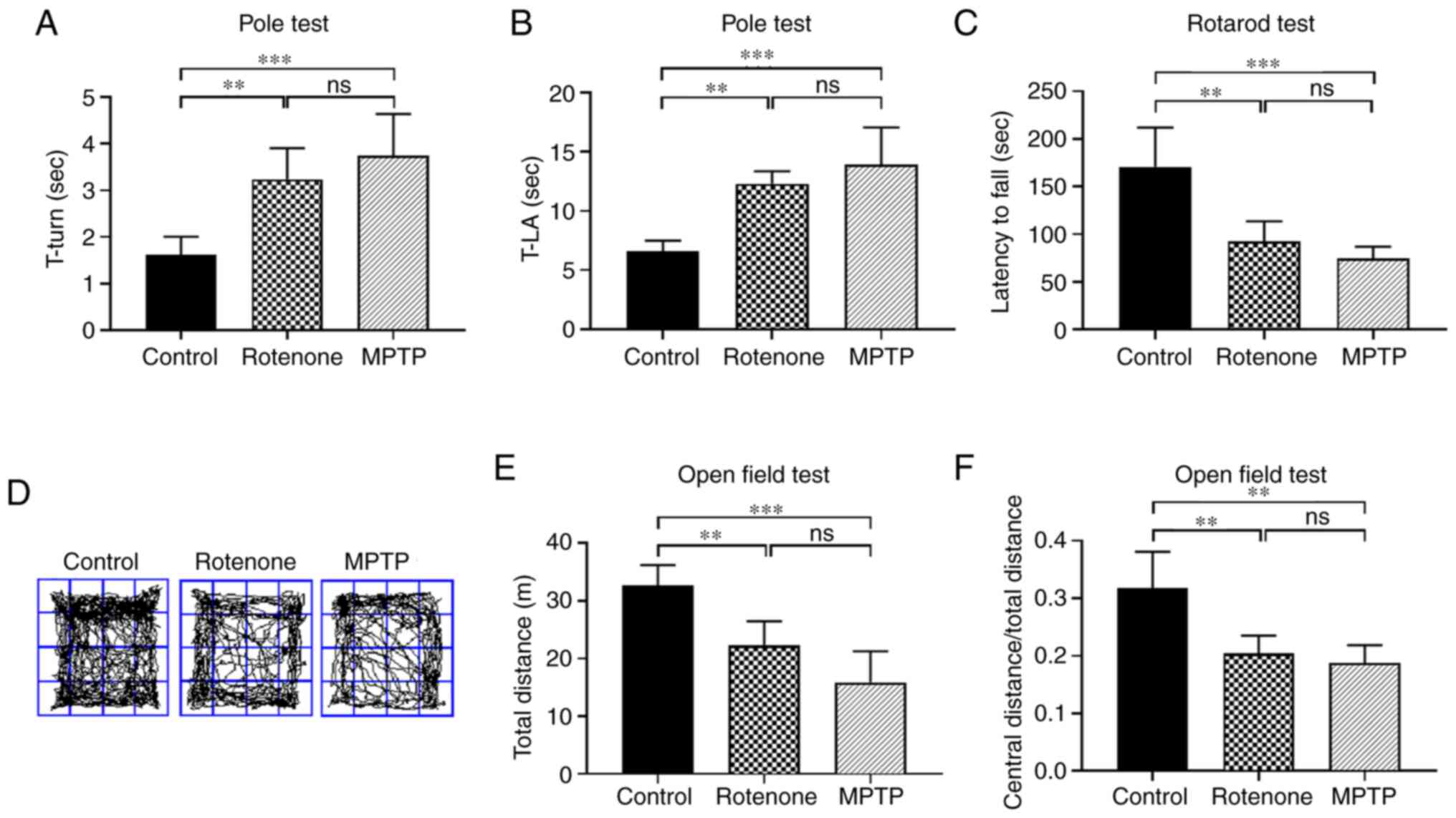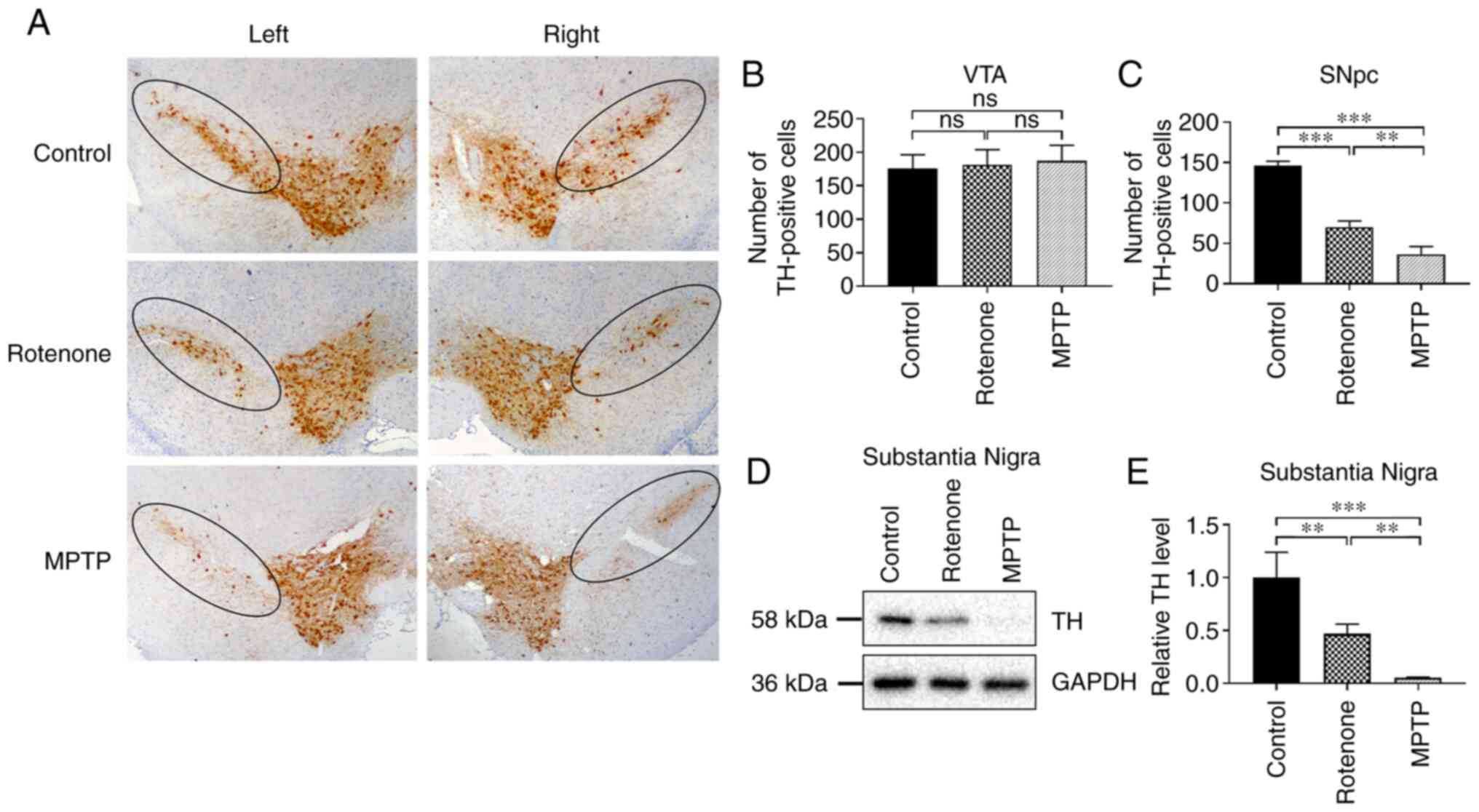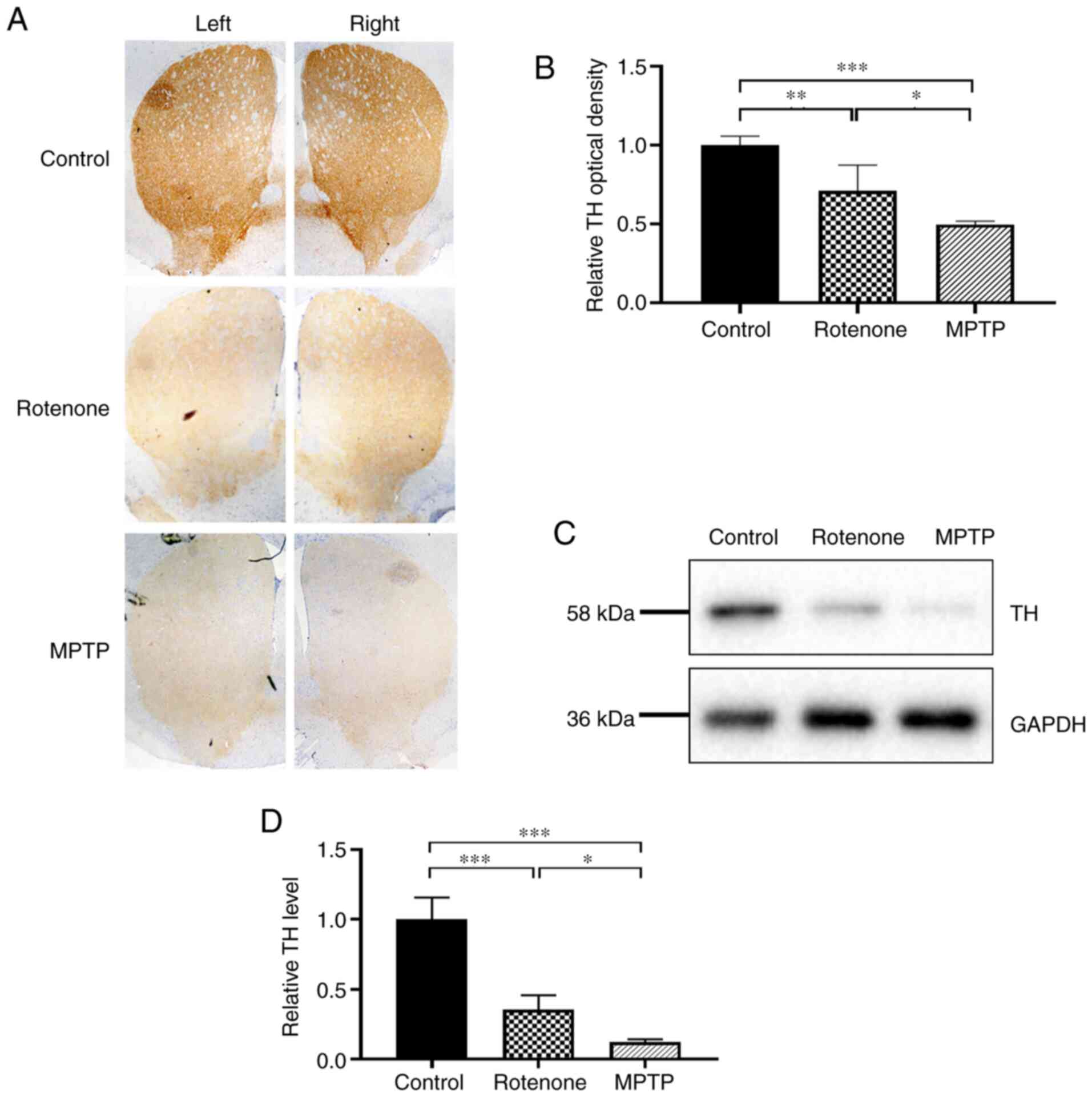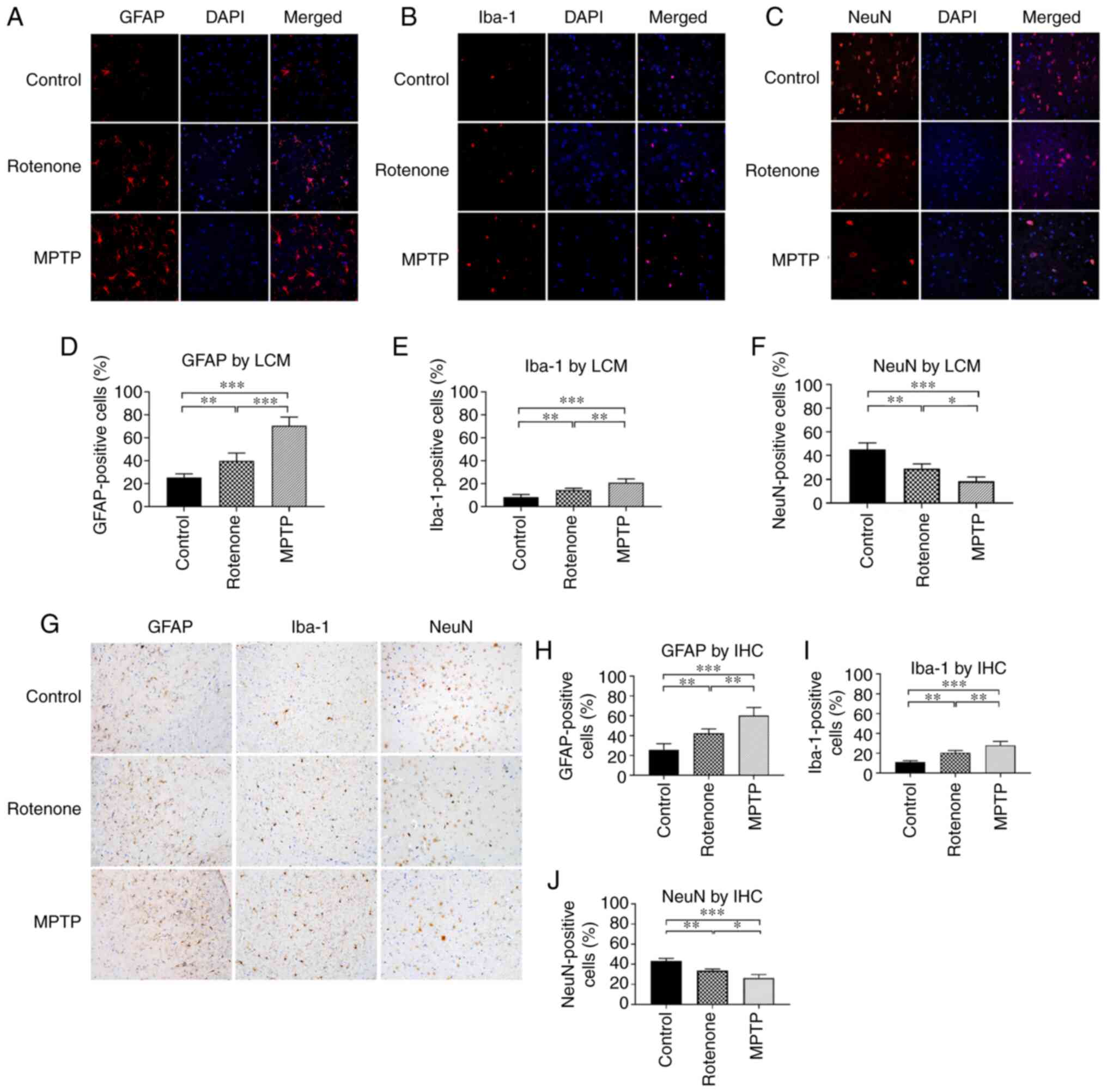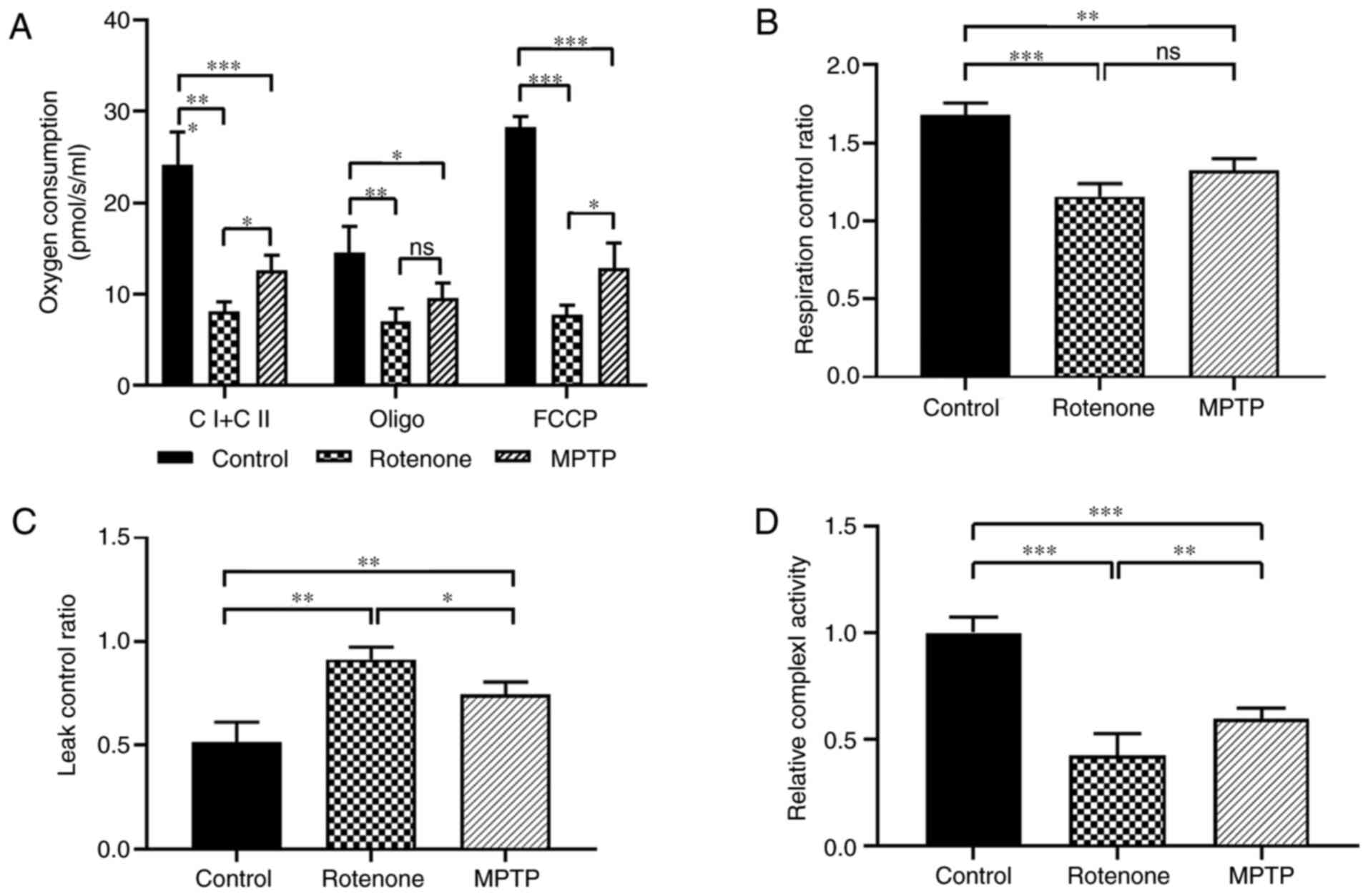|
1
|
Alamri Y, Pitcher T and Anderson TJ:
Variations in the patterns of prevalence and therapy in
Australasian Parkinson's disease patients of different ethnicities.
BMJ Neurol Open. 2:e0000332020. View Article : Google Scholar : PubMed/NCBI
|
|
2
|
Jankovic J: Parkinson's disease: Clinical
features and diagnosis. J Neurol Neurosurg Psychiatry. 79:368–376.
2008. View Article : Google Scholar : PubMed/NCBI
|
|
3
|
Schneider SA and Obeso JA: Clinical and
pathological features of Parkinson's disease. Curr Top Behav
Neurosci. 22:205–220. 2015. View Article : Google Scholar : PubMed/NCBI
|
|
4
|
Schapira AH and Jenner P: Etiology and
pathogenesis of Parkinson's disease. Mov Disord. 26:1049–1055.
2011. View Article : Google Scholar : PubMed/NCBI
|
|
5
|
Walter J, Bolognin S, Antony PMA, Nickels
SL, Poovathingal SK, Salamanca L, Magni S, Perfeito R, Hoel F, Qing
X, et al: Neural stem cells of Parkinson's disease patients exhibit
aberrant mitochondrial morphology and functionality. Stem Cell
Reports. 12:878–889. 2019. View Article : Google Scholar : PubMed/NCBI
|
|
6
|
Nakano M, Imamura H, Sasaoka N, Yamamoto
M, Uemura N, Shudo T, Fuchigami T, Takahashi R and Kakizuka A: ATP
maintenance via two types of ATP regulators mitigates pathological
phenotypes in mouse models of Parkinson's disease. EBioMedicine.
22:225–241. 2017. View Article : Google Scholar : PubMed/NCBI
|
|
7
|
Wi S, Lee JW, Kim M, Park CH and Cho SR:
An enriched environment ameliorates oxidative stress and olfactory
dysfunction in Parkinson's disease with α-Synucleinopathy. Cell
Transplant. 27:831–839. 2018. View Article : Google Scholar : PubMed/NCBI
|
|
8
|
De Miranda BR and Greenamyre JT:
Trichloroethylene, a ubiquitous environmental contaminant in the
risk for Parkinson's disease. Environ Sci Process Impacts.
22:543–554. 2020. View Article : Google Scholar : PubMed/NCBI
|
|
9
|
Merhi R, Kalyn M, Zhu-Pawlowsky A and
Ekker M: Loss of Parla function results in inactivity, olfactory
impairment, and dopamine neuron loss in Zebrafish. Biomedicines.
9:2052021. View Article : Google Scholar : PubMed/NCBI
|
|
10
|
Fifel K and Videnovic A: Chronotherapies
for Parkinson's disease. Prog Neurobiol. 174:16–27. 2019.
View Article : Google Scholar : PubMed/NCBI
|
|
11
|
Mursaleen L, Noble B, Chan SHY, Somavarapu
S and Zariwala MG: N-Acetylcysteine Nanocarriers protect against
oxidative stress in a cellular model of Parkinson's disease.
Antioxidants (Basel). 9:6002020. View Article : Google Scholar : PubMed/NCBI
|
|
12
|
Wang B, Su CJ, Liu TT, Zhou Y, Feng Y,
Huang Y, Liu X, Wang ZH, Chen LH, Luo WF and Liu T: The
Neuroprotection of Low-Dose morphine in cellular and animal models
of Parkinson's disease through ameliorating endoplasmic reticulum
(ER) stress and activating autophagy. Front Mol Neurosci.
11:1202018. View Article : Google Scholar : PubMed/NCBI
|
|
13
|
Zhou L, Zhang Q, Zhang P, Sun L, Peng C,
Yuan Z and Cheng J: C-Abl-Mediated Drp1 phosphorylation promotes
oxidative stress-induced mitochondrial fragmentation and neuronal
cell death. Cell Death Dis. 8:e31172017. View Article : Google Scholar : PubMed/NCBI
|
|
14
|
Bao XX, Ma HH, Ding H, Li WW and Zhu M:
Preliminary optimization of a Chinese herbal medicine formula based
on the neuroprotective effects in a rat model of rotenone-induced
Parkinson's disease. J Integr Med. 16:290–296. 2018. View Article : Google Scholar : PubMed/NCBI
|
|
15
|
Abdul-Latif R, Stupans I, Allahham A,
Adhikari B and Thrimawithana T: Natural antioxidants in the
management of Parkinson's disease: Review of evidence from cell
line and animal models. J Integr Med. 19:300–310. 2021. View Article : Google Scholar : PubMed/NCBI
|
|
16
|
Sai Y, Chen J, Ye F, Zhao Y, Zou Z, Cao J
and Dong Z: Dopamine release suppression dependent on an increase
of intracellular Ca(2+) contributed to rotenone-induced
neurotoxicity in PC12 Cells. J Toxicol Pathol. 26:149–157. 2013.
View Article : Google Scholar : PubMed/NCBI
|
|
17
|
De Lazzari F, Bubacco L, Whitworth AJ and
Bisaglia M: Superoxide radical dismutation as new therapeutic
strategy in Parkinson's disease. Aging Dis. 9:716–728. 2018.
View Article : Google Scholar : PubMed/NCBI
|
|
18
|
Qi Z, Miller GW and Voit EO: Rotenone and
paraquat perturb dopamine metabolism: A computational analysis of
pesticide toxicity. Toxicology. 315:92–101. 2014. View Article : Google Scholar : PubMed/NCBI
|
|
19
|
Benskey MJ, Perez RG and Manfredsson FP:
The Contribution of alpha synuclein to neuronal survival and
function-implications for Parkinson's disease. J Neurochem.
137:331–359. 2016. View Article : Google Scholar : PubMed/NCBI
|
|
20
|
San Miguel M, Martin KL, Stone J and
Johnstone DM: Photobiomodulation mitigates cerebrovascular leakage
induced by the Parkinsonian neurotoxin MPTP. Biomolecules.
9:5642019. View Article : Google Scholar : PubMed/NCBI
|
|
21
|
Dauer W and Przedborski S: Parkinson's
disease: Mechanisms and models. Neuron. 39:889–909. 2003.
View Article : Google Scholar : PubMed/NCBI
|
|
22
|
Razali K, Othman N, Mohd Nasir MH,
Doolaanea AA, Kumar J, Ibrahim WN, Mohamed Ibrahim N and Mohamed
WM: The promise of the Zebrafish model for Parkinson's disease:
Today's science and Tomorrow's treatment. Front Genet.
12:6555502021. View Article : Google Scholar : PubMed/NCBI
|
|
23
|
Bhurtel S, Katila N, Srivastav S, Neupane
S and Choi DY: Mechanistic comparison between MPTP and rotenone
neurotoxicity in mice. Neurotoxicology. 71:113–121. 2019.
View Article : Google Scholar : PubMed/NCBI
|
|
24
|
MacArthur Clark JA and Sun D: Guidelines
for the ethical review of laboratory animal welfare People's
Republic of China national standard GB/T 35892-2018 [Issued 6
February 2018 Effective from 1 September 2018]. Animal Model Exp
Med. 3:103–113. 2020. View Article : Google Scholar : PubMed/NCBI
|
|
25
|
Han X, Zhu J, Zhang X, Song Q, Ding J, Lu
M, Sun S and Hu G: Plin4-dependent lipid droplets hamper neuronal
mitophagy in the MPTP/p-induced mouse model of Parkinson's disease.
Front Neurosci. 12:3972018. View Article : Google Scholar : PubMed/NCBI
|
|
26
|
Zhou Q, Chen B, Wang X, Wu L, Yang Y,
Cheng X, Hu Z, Cai X, Yang J, Sun X, et al: Sulforaphane protects
against rotenone-induced neurotoxicity in vivo: Involvement of the
mTOR, Nrf2, and autophagy pathways. Sci Rep. 6:322062016.
View Article : Google Scholar : PubMed/NCBI
|
|
27
|
Li T, Zhang W, Kang X, Yang R, Li R, Huang
L, Chen J, Yang Q and Sun X: Salidroside protects dopaminergic
neurons by regulating the mitochondrial MEF2D-ND6 pathway in the
MPTP/MPP+-induced model of Parkinson's disease. J
Neurochem. 153:276–289. 2020. View Article : Google Scholar : PubMed/NCBI
|
|
28
|
Ogrodnik M, Zhu Y, Langhi LGP, Tchkonia T,
Krüger P, Fielder E, Victorelli S, Ruswhandi RA, Giorgadze N,
Pirtskhalava T, et al: Obesity-induced cellular senescence drives
anxiety and impairs neurogenesis. Cell Metab. 29:1061–1077.e8.
2019. View Article : Google Scholar : PubMed/NCBI
|
|
29
|
Wu CS, Chen H, Sun H, Zhu J, Jew CP,
Wager-Miller J, Straiker A, Spencer C, Bradshaw H, Mackie K and Lu
HC: GPR55, a G-protein coupled receptor for
lysophosphatidylinositol, plays a role in motor coordination. PLoS
One. 8:e603142013. View Article : Google Scholar : PubMed/NCBI
|
|
30
|
Zhang W, Zhou M, Lu W, Gong J, Gao F, Li
Y, Xu X, Lin Y, Zhang X, Ding L, et al: CNTNAP4 deficiency in
dopaminergic neurons initiates Parkinsonian phenotypes.
Theranostics. 10:3000–3021. 2020. View Article : Google Scholar : PubMed/NCBI
|
|
31
|
Liu J, Liu W, Lu Y, Tian H, Duan C, Lu L,
Gao G, Wu X, Wang X and Yang H: Piperlongumine restores the balance
of autophagy and apoptosis by increasing BCL2 phosphorylation in
rotenone-induced Parkinson disease models. Autophagy. 14:845–861.
2018. View Article : Google Scholar : PubMed/NCBI
|
|
32
|
Zhao QY, Ge LH, Zhang K, Chen HF, Zhan XX,
Yang Y, Dang QL, Zheng Y, Zhou HB, Lyu JX and Fang HZ: Assessment
of mitochondrial function in metabolic dysfunction-associated fatty
liver disease using obese mouse models. Zool Res. 41:539–551. 2020.
View Article : Google Scholar : PubMed/NCBI
|
|
33
|
Spinazzi M, Casarin A, Pertegato V,
Salviati L and Angelini C: Assessment of mitochondrial respiratory
chain enzymatic activities on tissues and cultured cells. Nat
Protoc. 7:1235–1246. 2012. View Article : Google Scholar : PubMed/NCBI
|
|
34
|
Liu J, Xu F, Nie Z and Shao L: Gut
microbiota Approach-A new strategy to treat Parkinson's disease.
Front Cell Infect Microbiol. 10:5706582020. View Article : Google Scholar : PubMed/NCBI
|
|
35
|
Shi W, Zhang Y, Zhao G, Wang S, Zhang G,
Ma C, Cong B and Li Y: Dysregulation of dopaminergic regulatory
factors TH, Nurr1, and Pitx3 in the ventral tegmental area
associated with neuronal injury induced by chronic morphine
dependence. Int J Mol Sci. 20:2502019. View Article : Google Scholar : PubMed/NCBI
|
|
36
|
Domanskyi A, Alter H, Vogt MA, Gass P and
Vinnikov IA: Transcription factors foxa1 and foxa2 are required for
adult dopamine neurons maintenance. Front Cell Neurosci. 8:2752014.
View Article : Google Scholar : PubMed/NCBI
|
|
37
|
Wang XH, Lu G, Hu X, Tsang KS, Kwong WH,
Wu FX, Meng HW, Jiang S, Liu SW, Ng HK, et al: Quantitative
assessment of gait and neurochemical correlation in a classical
murine model of Parkinson's disease. BMC Neurosci. 13:1422012.
View Article : Google Scholar : PubMed/NCBI
|
|
38
|
Kelly E, Vyas P and Weber JT: Biochemical
properties and neuroprotective effects of compounds in various
species of berries. Molecules. 23:262017. View Article : Google Scholar : PubMed/NCBI
|
|
39
|
Shin WH and Chung KC: Death-associated
protein kinase 1 phosphorylates α-Synuclein at ser129 and
exacerbates rotenone-induced toxic aggregation of α-Synuclein in
dopaminergic SH-SY5Y Cells. Exp Neurobiol. 29:207–218. 2020.
View Article : Google Scholar : PubMed/NCBI
|
|
40
|
Chen C, Wei YZ, He XM, Li DD, Wang GQ, Li
JJ and Zhang F: Naringenin produces neuroprotection against
LPS-induced dopamine neurotoxicity via the inhibition of microglial
NLRP3 inflammasome activation. Front Immunol. 10:9362019.
View Article : Google Scholar : PubMed/NCBI
|
|
41
|
Gangapuram M, Mazzio E, Eyunni S, Soliman
KF and Redda KK: Synthesis and biological evaluation of substituted
N-[3-(1H-Pyrrol-1-yl)Methyl]-1,2,5,6-tetrahydropyridin-1-yl]Benzamide/Benzene
sulfonamides as anti-inflammatory agents. Arch Pharm (Weinheim).
347:360–369. 2014. View Article : Google Scholar : PubMed/NCBI
|
|
42
|
Xu SF, Zhang YH, Wang S, Pang ZQ, Fan YG,
Li JY, Wang ZY and Guo C: Lactoferrin ameliorates dopaminergic
neurodegeneration and motor deficits in MPTP-treated mice. Redox
Biol. 21:1010902019. View Article : Google Scholar : PubMed/NCBI
|
|
43
|
Barbon S, Rajendran S, Bertalot T,
Piccione M, Gasparella M, Parnigotto PP, Di Liddo R and Conconi MT:
Growth and differentiation of circulating stem cells after
extensive ex vivo expansion. Tissue Eng Regen Med. 18:411–427.
2021. View Article : Google Scholar : PubMed/NCBI
|
|
44
|
Fang Y, Zhao C, Xiang H, Zhao X and Zhong
R: Melatonin inhibits formation of mitochondrial permeability
transition pores and improves oxidative phosphorylation of
frozen-thawed ram sperm. Front Endocrinol (Lausanne). 10:8962019.
View Article : Google Scholar : PubMed/NCBI
|
|
45
|
Gasperi V, Sibilano M, Savini I and Catani
MV: Niacin in the central nervous system: An update of biological
aspects and clinical applications. Int J Mol Sci. 20:9742019.
View Article : Google Scholar : PubMed/NCBI
|
|
46
|
Chia SJ, Tan EK and Chao YX: Historical
perspective: Models of Parkinson's disease. Int J Mol Sci.
21:24642020. View Article : Google Scholar : PubMed/NCBI
|
|
47
|
Jagmag SA, Tripathi N, Shukla SD, Maiti S
and Khurana S: Evaluation of models of Parkinson's disease. Front
Neurosci. 9:5032015.PubMed/NCBI
|
|
48
|
Goldman SM: Environmental toxins and
Parkinson's disease. Annu Rev Pharmacol Toxicol. 54:141–164. 2014.
View Article : Google Scholar : PubMed/NCBI
|
|
49
|
Zhang P, Qin D, Chen J and Zhang Z: Plants
in the genus tephrosia: Valuable resources for botanical
insecticides. Insects. 11:7212020. View Article : Google Scholar : PubMed/NCBI
|
|
50
|
Elbaz A and Moisan F: Update in the
epidemiology of Parkinson's disease. Curr Opin Neurol. 21:454–460.
2008. View Article : Google Scholar : PubMed/NCBI
|
|
51
|
Wirdefeldt K, Adami HO, Cole P,
Trichopoulos D and Mandel J: Epidemiology and etiology of
Parkinson's disease: A review of the evidence. Eur J Epidemiol. 26
(Suppl 1):S1–S58. 2011. View Article : Google Scholar : PubMed/NCBI
|
|
52
|
Das K, Ghosh M, Nag C, Nandy SP, Banerjee
M, Datta M, Devi G and Chaterjee G: Role of familial, environmental
and occupational factors in the development of Parkinson's disease.
Neurodegener Dis. 8:345–351. 2011. View Article : Google Scholar : PubMed/NCBI
|
|
53
|
McKnight S and Hack N: Toxin-Induced
Parkinsonism. Neurol Clin. 38:853–865. 2020. View Article : Google Scholar : PubMed/NCBI
|
|
54
|
Wang LY, Yu X, Li XX, Zhao YN, Wang CY,
Wang ZY and He ZY: Catalpol exerts a neuroprotective effect in the
MPTP mouse model of Parkinson's disease. Front Aging Neurosci.
11:3162019. View Article : Google Scholar : PubMed/NCBI
|
|
55
|
Tan Y, Xu Y, Cheng C, Zheng C, Zeng W,
Wang J, Zhang X, Yang X, Wang J, Yang X, et al: LY354740 reduces
extracellular glutamate concentration, inhibits phosphorylation of
Fyn/NMDARs, and expression of PLK2/pS129 α-Synuclein in mice
treated with acute or sub-acute MPTP. Front Pharmacol. 11:1832020.
View Article : Google Scholar : PubMed/NCBI
|
|
56
|
Jackson-Lewis V and Przedborski S:
Protocol for the MPTP mouse model of Parkinson's disease. Nat
Protoc. 2:141–151. 2007. View Article : Google Scholar : PubMed/NCBI
|
|
57
|
Li G, Luo W, Wang B, Qian C, Ye Y, Li Y
and Zhang S: HMGA1 induction of MiR-103/107 forms a negative
feedback loop to regulate autophagy in MPTP model of Parkinson's
disease. Front Cell Neurosci. 14:6200202020. View Article : Google Scholar : PubMed/NCBI
|
|
58
|
Meredith GE and Rademacher DJ: MPTP mouse
models of Parkinson's disease: An update. J Parkinsons Dis.
1:19–33. 2011. View Article : Google Scholar : PubMed/NCBI
|
|
59
|
Zhang QS, Heng Y, Mou Z, Huang JY, Yuan YH
and Chen NH: Reassessment of Subacute MPTP-treated mice as animal
model of Parkinson's disease. Acta Pharmacol Sin. 38:1317–1328.
2017. View Article : Google Scholar : PubMed/NCBI
|
|
60
|
Mustapha M and Mat Taib CN: MPTP-induced
mouse model of Parkinson's disease: A promising direction of
therapeutic strategies. Bosn J Basic Med Sci. 21:422–433.
2021.PubMed/NCBI
|
|
61
|
Sung YH: Effects of treadmill exercise on
hippocampal neurogenesis in an MPTP/Probenecid-induced Parkinson's
disease mouse model. J Phys Ther Sci. 27:3203–3206. 2015.
View Article : Google Scholar : PubMed/NCBI
|
|
62
|
Greenamyre JT, Betarbet R and Sherer TB:
The rotenone model of Parkinson's disease: Genes, environment and
mitochondria. Parkinsonism Relat Disord. 9 (Suppl 2):S59–S64. 2003.
View Article : Google Scholar : PubMed/NCBI
|
|
63
|
Inden M, Kitamura Y, Takeuchi H, Yanagida
T, Takata K, Kobayashi Y, Taniguchi T, Yoshimoto K, Kaneko M, Okuma
Y, et al: Neurodegeneration of mouse nigrostriatal dopaminergic
system induced by repeated oral administration of rotenone is
prevented by 4-Phenylbutyrate, a chemical chaperone. J Neurochem.
101:1491–1504. 2007. View Article : Google Scholar : PubMed/NCBI
|
|
64
|
Inden M, Kitamura Y, Abe M, Tamaki A,
Takata K and Taniguchi T: Parkinsonian rotenone mouse model:
Reevaluation of long-term administration of rotenone in C57bl/6
mice. Biol Pharm Bull. 34:92–96. 2011. View Article : Google Scholar : PubMed/NCBI
|
|
65
|
Lieu CA and Subramanian T: The
interhemispheric connections of the striatum: Implications for
Parkinson's disease and drug-induced dyskinesias. Brain Res Bull.
87:1–9. 2012. View Article : Google Scholar : PubMed/NCBI
|
|
66
|
Pravdic D, Hirata N, Barber L, Sedlic F,
Bosnjak ZJ and Bienengraeber M: Complex I and ATP synthase mediate
membrane depolarization and matrix acidification by isoflurane in
mitochondria. Eur J Pharmacol. 690:149–157. 2012. View Article : Google Scholar : PubMed/NCBI
|
|
67
|
Murphy MP: How mitochondria produce
reactive oxygen species. Biochem J. 417:1–13. 2009. View Article : Google Scholar : PubMed/NCBI
|
|
68
|
Zawada WM, Banninger GP, Thornton J,
Marriott B, Cantu D, Rachubinski AL, Das M, Griffin WS and Jones
SM: Generation of reactive oxygen species in
1-Methyl-4-Phenylpyridinium (MPP+) Treated dopaminergic neurons
occurs as an NADPH oxidase-dependent two-wave cascade. J
Neuroinflammation. 8:1292011. View Article : Google Scholar : PubMed/NCBI
|
|
69
|
Brichta L and Greengard P: Molecular
determinants of selective dopaminergic vulnerability in Parkinson's
disease: An update. Front Neuroanat. 8:1522014. View Article : Google Scholar : PubMed/NCBI
|
|
70
|
Morenas-Rodríguez E, Alcolea D,
Suárez-Calvet M, Muñoz-Llahuna L, Vilaplana E, Sala I, Subirana A,
Querol-Vilaseca M, Carmona-Iragui M, Illán-Gala I, et al: Different
pattern of CSF glial markers between dementia with Lewy bodies and
Alzheimer's disease. Sci Rep. 9:78032019. View Article : Google Scholar : PubMed/NCBI
|
|
71
|
Peng G, Qiu J, Liu H, Zhou M, Huang S, Guo
W, Lin Y, Chen X, Li Z, Li G, et al: Analysis of cerebrospinal
fluid soluble TREM2 and polymorphisms in sporadic Parkinson's
disease in a Chinese population. J Mol Neurosci. 70:294–301. 2020.
View Article : Google Scholar : PubMed/NCBI
|
|
72
|
Wilson EN, Swarovski MS, Linortner P,
Shahid M, Zuckerman AJ, Wang Q, Channappa D, Minhas PS, Mhatre SD,
Plowey ED, et al: Soluble TREM2 is elevated in Parkinson's disease
subgroups with increased CSF Tau. Brain. 143:932–943. 2020.
View Article : Google Scholar : PubMed/NCBI
|
|
73
|
Mo M, Tang Y, Wei L, Qiu J, Peng G, Lin Y,
Zhou M, Dai W, Zhang Z, Chen X, et al: Soluble triggering receptor
expressed on myeloid cells 2 from cerebrospinal fluid in sleep
disorders related to Parkinson's disease. Front Aging Neurosci.
13:7532102021. View Article : Google Scholar : PubMed/NCBI
|
|
74
|
Liss B, Haeckel O, Wildmann J, Miki T,
Seino S and Roeper J: K-ATP channels promote the differential
degeneration of dopaminergic midbrain neurons. Nat Neurosci.
8:1742–1751. 2005. View
Article : Google Scholar : PubMed/NCBI
|
|
75
|
Han SS, Jiao Q, Bi MX, Du XX and Jiang H:
The expression of KATP channel subunits in
alpha-synuclein-transfected MES23.5 cells. Ann Transl Med.
6:1702018. View Article : Google Scholar : PubMed/NCBI
|
|
76
|
Dickson DW: Neuropathology of Parkinson
disease. Parkinsonism Relat Disord. 46 (Suppl 1):S30–S33. 2018.
View Article : Google Scholar : PubMed/NCBI
|
|
77
|
Burré J, Sharma M and Südhof TC: Cell
biology and pathophysiology of α-Synuclein. Cold Spring Harb
Perspect Med. 8:a0240912018. View Article : Google Scholar : PubMed/NCBI
|
|
78
|
Silva BA, Einarsdottir O, Fink AL and
Uversky VN: Biophysical characterization of α-Synuclein and
rotenone interaction. Biomolecules. 3:703–732. 2013. View Article : Google Scholar : PubMed/NCBI
|
|
79
|
Wang Y, Shinoda Y, Cheng A, Kawahata I and
Fukunaga K: Epidermal fatty acid-binding protein 5 (FABP5)
Involvement in alpha-synuclein-induced mitochondrial injury under
oxidative stress. Biomedicines. 9:2021. View Article : Google Scholar
|
|
80
|
Cookson MR and van der Brug M: Cell
systems and the toxic mechanism(s) of alpha-synuclein. Exp Neurol.
209:5–11. 2008. View Article : Google Scholar : PubMed/NCBI
|
|
81
|
Rocha EM, De Miranda B and Sanders LH:
Alpha-Synuclein: Pathology, mitochondrial dysfunction and
neuroinflammation in Parkinson's disease. Neurobiol Dis.
109:249–257. 2018. View Article : Google Scholar : PubMed/NCBI
|
|
82
|
Plotegher N and Duchen MR: Crosstalk
between lysosomes and mitochondria in Parkinson's disease. Front
Cell Dev Biol. 5:1102017. View Article : Google Scholar : PubMed/NCBI
|
|
83
|
Turner C and Schapira AH: Mitochondrial
dysfunction in neurodegenerative disorders and ageing. Adv Exp Med
Biol. 487:229–251. 2001. View Article : Google Scholar : PubMed/NCBI
|
|
84
|
Betarbet R, Sherer TB, MacKenzie G,
Garcia-Osuna M, Panov AV and Greenamyre JT: Chronic systemic
pesticide exposure reproduces features of Parkinson's disease. Nat
Neurosci. 3:1301–1306. 2000. View
Article : Google Scholar : PubMed/NCBI
|
|
85
|
Udhayabanu T, Manole A, Rajeshwari M,
Varalakshmi P, Houlden H and Ashokkumar B: Riboflavin responsive
mitochondrial dysfunction in neurodegenerative diseases. J Clin
Med. 6:522017. View Article : Google Scholar : PubMed/NCBI
|
|
86
|
Ho PW, Ho JW, Liu HF, So DH, Tse ZH, Chan
KH, Ramsden DB and Ho SL: Mitochondrial neuronal uncoupling
proteins: A target for potential disease-modification in
Parkinson's disease. Transl Neurodegener. 1:32012. View Article : Google Scholar : PubMed/NCBI
|
|
87
|
Luo Y, Hoffer A, Hoffer B and Qi X:
Mitochondria: A therapeutic target for Parkinson's disease? Int J
Mol Sci. 16:20704–20730. 2015. View Article : Google Scholar : PubMed/NCBI
|
|
88
|
Patil DA, Patil VA, Bari SB, Surana SJ and
Patil PO: Animal models for Parkinson's disease. CNS Neurol Disord
Drug Targets. 13:1580–1594. 2014. View Article : Google Scholar : PubMed/NCBI
|



